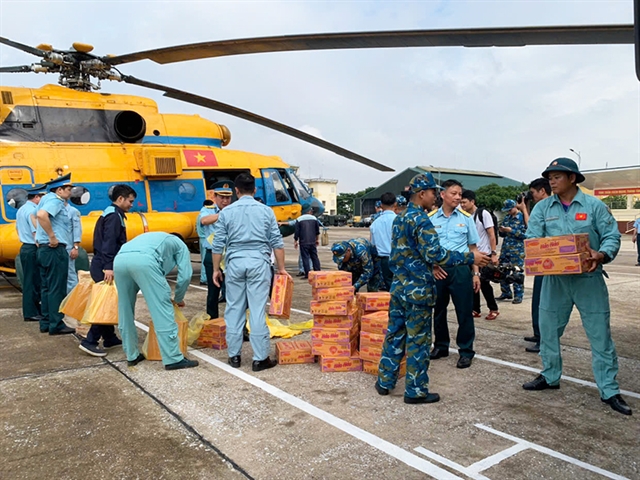 Features
Features

Around 20 years ago, farmers in Long An Province’s Châu Thành District began to grow dragon fruit instead of paddy, which did not yield much profit. The fruit, now grown on almost 90 per cent of the land, has brought about a miraculous economic transformation, Văn Đạt discovers.
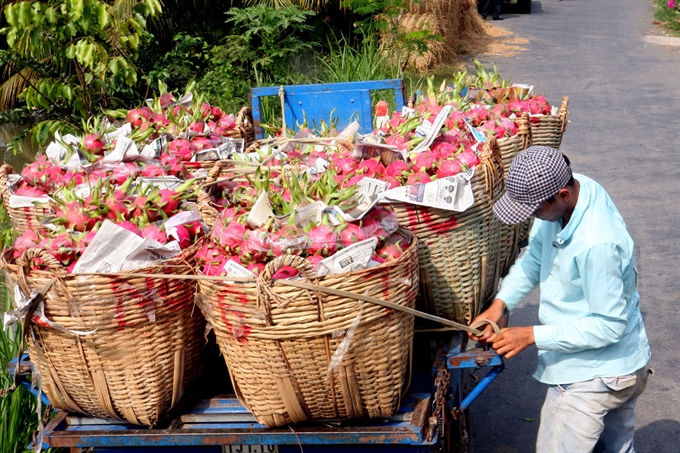 |
| The day’s haul: A local farmer loads dragon fruit to sell at markets. VNA/VNS Photo Đình Huệ |
Around 20 years ago, farmers in Long An Province’s Châu Thành District began to grow dragon fruit instead of paddy, which did not yield much profit. The fruit, now grown on almost 90 per cent of the land, has brought about a miraculous economic transformation, Văn Đạt discovers.
In the Mekong Delta, Việt Nam’s biggest rice basket, paddies are ubiquitous. Except here.
Along street after street in Châu Thành, a rural district in Long An Province, the unbroken green of dragon fruit farms has replaced the yellow of ripe paddy fields.
The place usually buzzes with activity as lorries, container trucks and tricycles loaded with dragon fruit hurry back and forth between the farms and the slew of fruit processing plants in Tầm Vu, a nearby town.
Almost 80 per cent of the fruit harvested here are exported to China, the US, Japan, the EU and other markets.
As people break out into easy smiles, it is not hard to guess that local farmers make a great deal of money for their toil.
It is not yet the peak harvest season, which is a couple of weeks from now.
To outsiders, the talk here seems to be solely about the fruit: on farms, in markets, at coffee shops, and even the party table.
But it should come as no surprise since it has been a source of prosperity for most people here for years. Some even think the fruit has wrought a miracle, turning a poor district with tired, dry soil into a wealthy agricultural area.
There has been a palpable improvement in the economic situation of virtually every household and ward since farmers stopped cultivating paddy a few decades ago and switched to the fruit.
People made the switch since it is not a well irrigated area and rice needs a lot of water whereas dragon fruit plants are more resilient to drought as well as more lucrative. Household followed successful household and the area under the fruit kept expanding until it was dubbed the ‘dragon fruit kingdom’.
The district has around 8,000 hectares of agricultural land, and almost 7,000ha are under dragon fruit. Less than 1,500ha of paddy are left, but clearly their days are numbered.
Across the district, almost everyone is involved with the fruit. This includes migrant workers from other provinces who came here to work on the farms, help package and transport the fruit, sell farm inputs or trade in the fruit.
Châu Thành used to rank among the poorest districts in Long An, but is now among the wealthiest.
Using traditional poverty measures, only 1 per cent of its population is poor, and this rises to 3.7 per cent if the recent multi-dimensional poverty standards are adopted. But the rate is much lower than that of neighbouring districts, according to the local administration.
Nguyễn Văn Thình, the chairman of the Châu Thành District People’s Committee, recalls that a decade ago authorities had to invest much effort in poverty reduction, offering vocational training courses and creating job opportunities. But now the living conditions of most people have improved, he says.
“The affluence means it is easy for the local government to mobilise funds [from the public] for building infrastructure such as water supply system, roads and others.”
It is fairly common in Việt Nam for the people to contribute money and labour for public works, especially in the countryside.
Lives changed
Nguyễn Tiến Lĩnh, 27, who persuaded his parents to plant dragon fruit instead of paddy five years ago on their 1ha farm, cannot forget what happened after the first harvest.
“I could not control my hands from shaking while counting VNĐ500 million (over $22,700) given by a trader who bought out dragon fruit. With paddy, my family earned at most VNĐ30 million if it was a bumper crop.
“My family is not alone. Now most people in this district live without worrying about money.”
Lĩnh’s mother, Phạm Thị Hai, had similar feelings when they got the large amount of money: “My heart was racing the first time. But later it became normal.”
Sitting in her house in An Lục Long Commune, with a smile never far away, she recalled her family’s economic situation was not good before 2010 when they were growing paddy.
The money they got from the harvest would only be enough to meet farming expenses. Her house used to be empty. Little did she dream that one day she would buy a lot of things for the house and have a large sum of money in the bank.
Pointing to new lavish houses in the neighbourhood, Hai says all their owners also grow dragon fruit. There are barely any thatched houses left in her commune, she says.
“I plan to buy more land since I am aware the soil here is highly suitable for dragon fruit. With paddy, the district used to be the poorest in the province.”
Lê Nguyên Đáng, 36, of the same commune is happy to talk about the good fortune that the fruit bestowed upon his family and the fortuitous manner of his switch from rice farming.
“When all neighbouring farms switched to dragon fruit, I could not grow paddy any more since ploughing and harvesting machines had no way to reach my farm.”
He decided to grow the fruit himself.
He said: “I was shocked when I held a hundred million đồng after selling my first harvest.”
Some 20 years ago many locals began to grow dragon fruit since paddy was not profitable. But their income was nothing to boast about since the fruit was not exported and was mostly consumed domestically.
In a region that was not the wettest, the hardy fruit became popular and gradually more than 90 per cent of farmlands in the district were brought under it.
Farmers say half-jokingly that the recent drought has brought tears to farmers in other parts of the country, but good fortune to them.
In Bình Thuận Province in the central region, another major dragon fruit-growing area, the crop has been very poor.
Also luckily, Châu Thành has a river and canals, though this year the saltwater intrusion in them has been unusually intense.
As a result of the poor crop in other places, red dragon fruit prices have skyrocketed to VNĐ60,000 per kilogram.
Since 2010 the district government has encouraged farmers to grow the fruit, Thình says.
It plans by 2020 to have all 8,000ha under the fruit.
Large farm
Châu Thành produces 250,000 tonnes of dragon fruit annually and exports mostly to China, though some portion is also shipped to South Korea, Japan, the US and other markets. The Trans-Pacific Partnership and several other free trade agreements that Việt Nam has signed are likely to help expand the market for them.
But exporting to demanding markets like the US, Japan and EU would require an improvement in quality. For this purpose, the district has persuaded farmers to pool together 2,000ha to achieve economies of scale and apply modern technologies.
“In order to better manage the 2,000ha farm, we have decided to establish 20 co-operatives, with each taking responsibility for 100ha,” Thình said, adding that VietGap quality standards would be adopted.
The project has received strong support from local farmers, who realise it will help them reduce costs and improve quality. — VNS
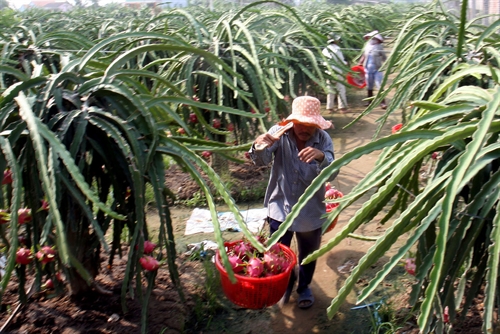 |
| Fruits of labour: Dragon fruit brings better livelihoods to local farmers. VNA/VNS Photo Đình Huệ |
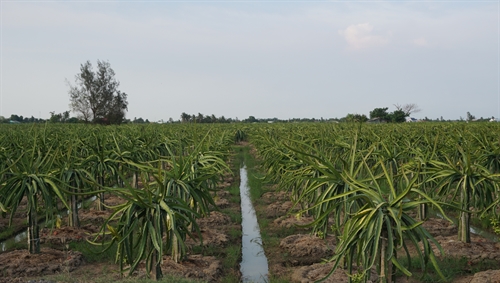 |
| Go-to crop: Dragon fruit farms meet the eye wherever one turns in Châu Thành. VNS Photo Văn Đạt |
 |
| Prized pick: Phạm Thị Hai, 55, of An Luc Long Commune, with a ripe fruit on her farm. VNS Photo Văn Đạt |
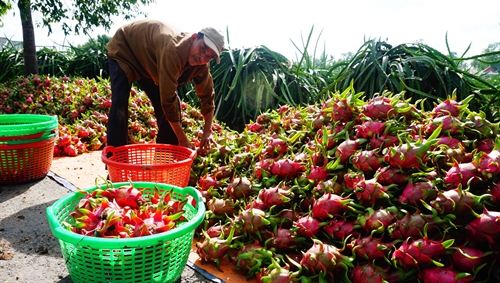 |
| The hard part is over: A Châu Thành farmer brings his newly-harvested red dragon fruits to the road to wait for traders. VNS Photo Văn Đạt |

